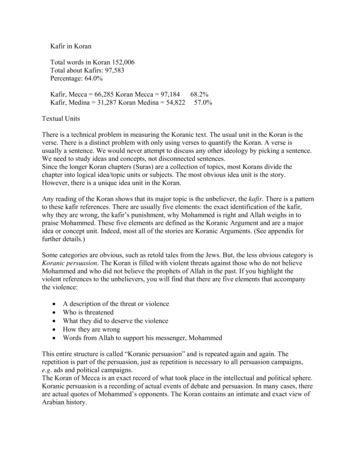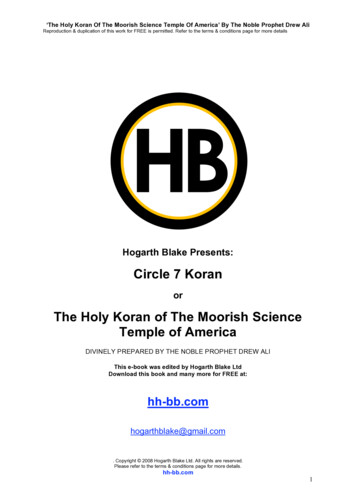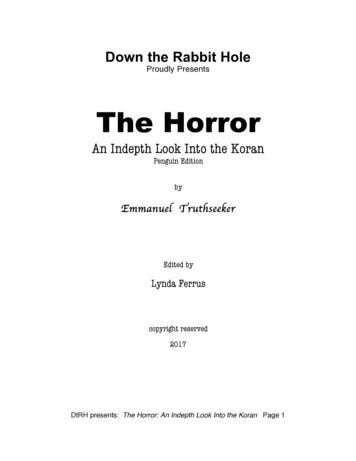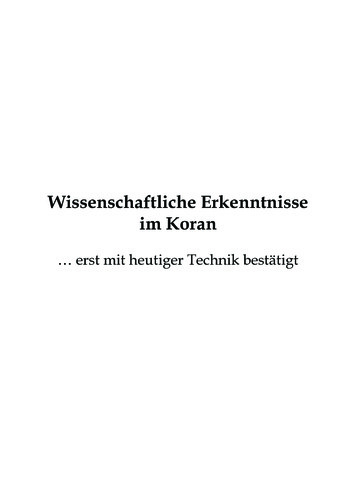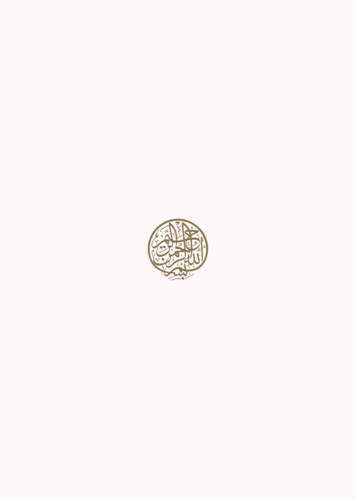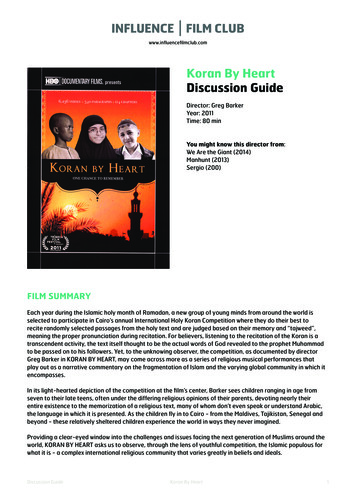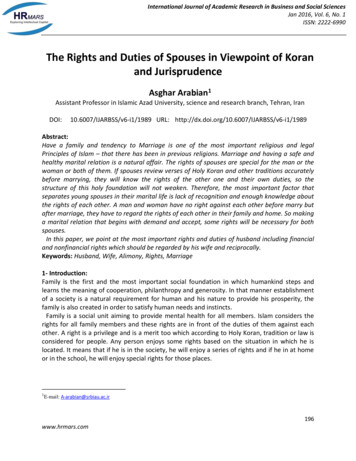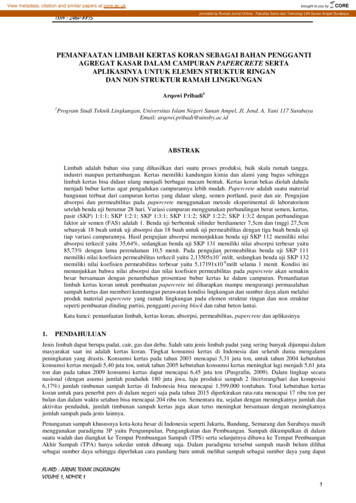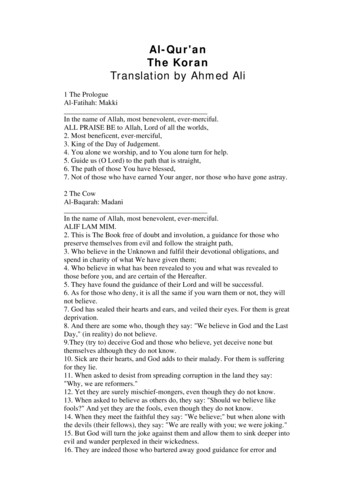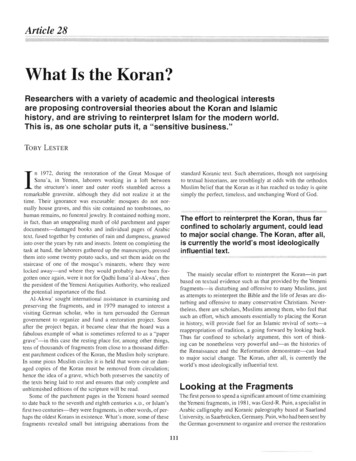
Transcription
Article 28What Is the Koran?Researchers with a variety of academic and theological interestsare proposing controversial theories about the Koran and Islamichistory, and are striving to reinterpret Islam for the modern world.This is, as one scholar puts it, a "sensitive business."TOBY LESTERn 1972, during the restoration of the Great Mosque ofSana ' a, in Yemen, laborers working in a loft betweenthe structure 's inner and outer roofs stumbled across aremarkable gravesite, al though they did not realize it at thetime. Their ignorance was excu sa ble: mosques do not nor mally house graves, and thi s site contained no tombstones, nohuman remains, no funereal jewelry. It contained nothing more,in fact, than an unappealing mas h of old parchment and paperdocuments-damaged books and individual pages of Arabictext, fused together by centuries of rain and dampness, gnawedinto over the years by rats and insect s. Intent on completing thetask at hand, the laborers gathered up the manuscripts, pressedthem into some twenty potato sacks, and set them aside on thestaircase of one of the mosque's minarets, where they werelocked away-and where they would probably have been for gotten once again, were it not for Qadhi Isma'il al-Akwa', thenthe president of the Yemeni Antiquities Authority, who realizedthe potential importance of the find .Al-Akwa' sought international ass istance in examining andpreserving the fragments, and in 1979 managed to interest avisiting German scholar, who in turn persuaded the Germangovernment to organize and fund a restoration project. Soonafter the project began, it became clear that the hoard was afabulous example of what is sometimes referred to as a "papergrave"-in this case the resting place for, among other things,tens of thou sands of fragments from close to a thou sand differ ent parchment codices of the Koran , the Mu slim holy scripture.In some pious Muslim circles it is held that worn-out or dam aged copies of the Koran mu st be removed from circulation;hence the idea of a grave , which both preserves the sanctity ofthe texts being laid to rest and ensures that only complete andunblemished editions of the scripture will be read.Some of the parchment pages in the Yemeni hoard seemedto date back to the seven th and eighth centuries A.D., or Islam'sfirst two centuries-they were fragments, in other words, of per haps the oldest Korans in existence. What 's more, some of thesefragments revealed small but intriguing aberrations from theI111standard Koranic text. Such aberrations, though not surprisingto textual historians, are troublingly at odds with the orthodoxMuslim belief that the Koran as it has reached us today is quitesimply the perfect, timeless, and unchanging Word of God.The effort to reinterpret the Koran, thus farconfined to scholarly argument, could leadto major social change. The Koran, after all,is currently the world's most ideologicallyinfluential text.The mainly secular effort to reinterpret the Koran-in partbased on textual evidence such as that provided by the Yemenifragments-is disturbing and offensive to many Muslims, justas attempts to reinterpret the Bible and the life of Jesus are dis turbing and offensive to many conservative Christians. Never theless , there are scholars, Muslims among them, who feel thatsuch an effort, which amounts essentially to placing the Koranin history, will provide fuel for an Islamic revival of sorts-areappropriation of tradition , a going forward by looking back.Thus far confined to scholarly argument, thi s sort of think ing can be nonetheless very powerful and-as the hi stories ofthe Renaissance and the Reformation demon strate---can leadto major social change. The Koran , after all, is currently theworld's most ideologically influential text.Looking at the FragmentsThe first person to spend a significant amount of time examiningthe Yemeni fragments , in 1981 , was Gerd-R. Puin , a specialist inArabic calligraphy and Koranic paleography based at SaarlandUniversity, in SaarbrUcken, Germany. Puin, who had been sent bythe German government to organize and oversee the restoration
ANNUAL EDITIONSproject, recognized the antiquity of some of th e parchmentfragments, and his preliminary inspection also revealedunconventional verse orderings, minor textual variations, andrare styles of orthography and artistic embellishment. Enticing,too, were the sheets of the scripture written in the rare and earlyHijazi Arabic script: pieces of the earliest Korans known toexist, they were also palimpsests-versions very clearly writtenover even earlier, washed-off version s. What the Yemeni Koransseemed to suggest, Puin began to feel , was an evolving textrather than simply the Word of God as revealed in its entirety tothe Prophet Muhammad in the seventh century A.D .Since the early 1980s more than 15,000 sheets of the YemeniKorans have painstakingly been flattened, cleaned, treated,sorted, and assembled; they now sit ("preserved for anotherthou sand years," Puin says) in Yemen 's Hou se of Manuscripts,awaiting detailed examination. That is something the Yemeniauthorities have seemed reluctant to allow, however. "Theywant to keep this thing low-profile, as we do too , although fordifferent reasons," Puin explains. "They don't want attentiondraw n to the fact that there are Germans and others working onthe Korans. They don 't want it made public that there is workbeing done at all, since the Mu slim position is that everythingthat needs to be said about the Koran's history was said a thou sand years ago."To date just two scholars have been granted extensive accessto the Yemeni fragments: Puin and his colleague H .-C. Grafvon Bothmer, an Islamic-art historian also based at SaarlandUniversi ty. Puin and von Bothmer have published only a fewtanta lizingly brief articles in scholarly publications on whatthey have discovered in the Yemani fragments . They havebeen reluctant to publish partly because until recently theywere more concerned with sorting and classifying the frag ments than with systematically examining them , and partlybccause they felt that the Yemeni authorities, jf they realizedthe possible implications of the discovery, might refuse themfurther access. Von B othmer, however, in 1997 fini s hed takingmore than 35,000 microfilm pictures of the fragments , and hasrecently brought the pictures back to Germany. Thi s mean s thatsoon von Bothmer, Puin , and other scholars will fin ally havea chance to scrutinize the texts and to publish their findingsfreely-a prospect that thrills Puin. "So many Muslims havethis belief that everything between the two covers of the Koranis just God's unaltered word," he says. "They like to quote thetextual work that shows that the Bible has a hi story and did notfall straight out of the sky, but until now the Koran has been outof this discussion. The only way to break through this wall isto prove that the Koran has a history too. The Sana ' a fragmentswill help us to do thi s."Puin is not alone in hi s enthusiasm. "The impact of the Yemenimanuscripts is still to be felt," says Andrew Rippin , a professorof religious studies at the University of Calgary, who is at theforefront of Koranic studies today. "Their variant readings andverse orders are all very significant. Everybody agrees on that.These manuscripts say that the early history of the Koranic textis much more of an open question than many have suspected:the text was less stable, and therefore had less authority, thanhas always been claimed ."112Copyediting GodBy the standards of contemporary biblical scholarship, most ofthe questions being posed by sc holars like Puin and Rippin arerather modest; outside an Islamic context, proposing that theKoran has a history and suggesting that it can be interpretedmetaphorically are not radical steps. But the Islamic context and Muslim sensibilities-cannot be ignored . "To historicize theKoran would in effect delegitimize the whole historical experi ence of the Muslim community," says R. Stephen Humphreys ,a professor of Islamic s tudies at the University of California atSanta Barbara. "The Koran is the charter for the community,th e document that called it into existence. And ideally-thoughobviously not always in reality- Islamic history has been theeffort to pursue and work out the commandments of the Koranin human life. If the Koran is a historical document, then thewhole Islamic struggle of fourteen centuries is effectivelymeaningless."The 0l1hodox Muslim view of the Koran as self-evidentl ythe Word of God, perfect and inimitable in message, language,style, and form, is strikingly similar to the fundamentalist Chris tian notion of the Bible's " inerrancy" and "verbal inspiration"that is still common in man y places today. The notion was givenclassic expression only a little more than a century ago by thebiblical scholar John William Burgan.The Bible is none other than the voice of Him thai si/lelhupon the Throne' Every Book of it, every Chapter ofit, every Verse of it, every word of it, every syllable ofit . every letter of it, is the direct utterance of the MostHigh!Not all the Christians think this way about the Bible, how ever, and in fact, as the Encyclopaedia of Islam (1981) pointsout, "the closest analogue in Christian belief to the role of theKur' an in Muslim belief is not the Bible, but Christ." If Christis the Word of God made flesh, the Koran is the Word of Godmade text, and questioning its sanctity or authority is thus con sidered an outright attack on Islam-as Salman Rushdie knowsall too well.The prospect of a Muslim backlash has not deterred thecritical-historical study of the Koran, as the existence of theessays in The Origins of Ihe Koran (1998) demonstrate. Evenin the aftermath of the Rushdie affair the work continues:In 1996 the Koranic sc holar GUnter LUling wrote in Th eJournal of High er Criticism about "the wide extent to whichboth the text of the Koran and the learned Islamic accountof Islamic origins have been distorted, a deformationunsuspectingl y accepted by Wes tern Islamici sts until now."In 1994 the journal Jerusa lem Studies in Arabic and Islampublished a posthumous study by Yehuda D. Nevo, of theHebrew University in Jerusalem, detailing seventh- andeighth-century religiou s inscription s on stones in the NegevDesert which , Neva suggested , po se "considerable problemsfor the traditional Musli m account of the history of Islam."That sa me year, and in the same journal, Patrici a Crone, ahistorian of early Islam currently based at the Institute forAdvanced Study, in Princeton, New Jersey, published an
Article 28. What Is the Koran?article in which she argued that elucidating problematicpassages in the Koranic text is likely to be made possible onlyby "abandoning the conventional account of how the Qur'anwas born." And since 1991 James Bellamy, of the Universityof Michigan, has proposed in the Journal of the AmericanOriental Society a series of "emendations to the tex.t of theKoran"-changes that from the orthodox Muslim perspectiveamount to copyediting God.Crone is one of the most iconoclastic of these scholars. Dur ing the 1970s and 1980s she wrote and collaborated on severalbooks-most notoriously, with Michael Cook, Hagarism: TheMaking of the Islamic World (1977)-that made radical argu ments about the origins of Islam and the writing of Islamichistory. Among Hagarism' s controversial claims were sugges tions that the text of the Koran came into being later than isnow believed ("There is no hard evidence for the exi stence ofthe Koran in any form before the last decade of the seventhcentury"); that Mecca was not the initial Islamic sanctuary("[the evidence] points unambiguously to a sanctuary in north west Arabia . . Mecca was secondary"); that the Arab con quests preceded the institutionalization of Islam ("the Jewishmessianic fantasy was enacted in the form of an Arab conquestof the Holy Land"); that the idea of the hijra, or the migra tion of Muhammad and his followers from Mecca to Medinain 622, may have evolved long after Muhammad died ("Noseventh-century source identifies the Arab era as that of thehijra" ); and that the term "Muslim" was not commonly usedin early Islam ("There is no good reason to suppose that thebearers of this primitive identity called themselves 'Muslims'[but] sources do . . reveal an earlier designation of the com munity [which] appears in Greek as 'Magaritai' in a papyrusof 642, and in Syriac as 'Mahgre' or 'Mahgraye' from as earlyas the 640s" ).Hagarism came under immediate attack, from Muslimand non-Muslim scholars alike, for its heavy reliance on hos tile sources. ("This is a book ," the authors wrote, "based onwhat from any Muslim perspective must appear an inordinateregard for the testimony of infidel sources.") Crone and Cookhave since backed away from some of its most radical propo sitions-such as, for example, that the Prophet Muhammadlived two years longer than the Muslim tradition claims he did,and that the historici ty of his migration to Medina is question able. But Crone has continued to challenge both Muslim andWestern orthodox views of Islamic history. In Meccan Tradeand the Rise of Islam (1987) she made a detailed argumentchallenging the prevailing view among Western (and someMuslim) scholars that Islam arose in response to the Arabianspice trade .Gerd-R. Puin's current thinking about the Koran's historypartakes of this contemporary revisionism. "My idea is that theKoran is a kind of cocktail of texts that were not all understoodeven at the time of Muhammad," he says. "Many of them mayeven be a hundred years older than Islam itself. Even withinthe Islamic traditions there is a huge body of contradictoryinformation, including a significant Christian substrate; onecan derive a whole Islamic anti-history from them if onewants ."113The Koran is a scripture with a history likeany other," one scholar says, "except thatwe tend to provoke howls of protest whenwe study it. But we are not trying to destroyanyone's faith.Patricia Crone defends the goals of this sort of thinking. "TheKoran is a scripture with a history like any other-except thatwe don't know this history and tend to provoke howls of pro test when we study it. Nobody would mind the howls if theycame from Westerners, but Westerners feel deferential when thehowls come from other people: who are you to tamper withtheir legacy? But we Islamicists are not trying to destroy any one's faith."Not everyone agrees with that assessment-especially sinceWestern Koranic scholarship has traditionally taken place inthe context of an openly declared hostility between Christian ity and Islam. (Indeed , the broad movement in the West overthe past two centuries to "explain" the East, often referred to asOrientalism, has in recent years come under fire for eXhibitingsimilar religious and cultural biases). The Koran has seemed,for Christian and Jewish scholars particularly, to possess an auraof heresy ; the nineteenth-century Orientalist William Muir, forexample, contended that the Koran was one of "the most stub born enemies of Civilisation, Liberty, and the Truth which theworld has yet known ." Early Soviet scholars, too, undertook anideologically motivated study of Islam's origins, with almostmissionary zeal: in the 1920s and in 1930 a Soviet publicationtitled Ateist ran a series of articles explaining the rise of Islamin Marxist-Leninist terms. In Islam and Russia (1956) , AnnK. S. Lambton summarized much of this work, and wrote thatseveral Soviet scholars had theorized that "the motive force ofthe nascent religion was supplied by the mercantile bourgeoi sie of Mecca and Medina"; that a certain S. P. Tolstov had heldthat "Islam was a social-religious movement originating in theslave-owning, not feudal, form of Arab society"; and that N. A.Morozov had argued that " until the Crusades Islam was indis tinguishable from Judaism and . . only then did it receive itsindependent character, while Muhammad and the first Caliphsare mythical figures." Morozov appears to have been a particu larly tlamboyant theorist: Lambton wrote that he also argued,in his book Christ (1930), that "in the Middle Ages Islam wasmerely an off-shoot of Arianism evoked by a meteorologicalevent in the Red Sea area near Mecca ."Not surprisingly, then, given the biases of much non-Islamiccritical study of the Koran, Muslims are inclined to dism.iss itoutright. A particularly eloquent protest came in 1987, in theMuslim World Book Review, in a paper titled "Method AgainstTruth: Orientalism and Qur'anic Studies," by the Muslim criticS. Parvez Manzoor. Placing the origins of Western Koranicscholarship in "the polemical marshes of medieval Christian ity" and describing its contemporary state as a "cul-de-sac ofits own making," Manzoor orchestrated a complex and layeredassault on the entire Western approach to Islam. He opened hisessay in a rage.
- - - - -- ------.ANNUAL EDITIONSThe Orientalist enterprise of Qur'anic studies, whatever itsother merits and services, was a project born of spite, bredin frustration and nourished by vengeance: the spite of thepowerful for the powerless, the frustration of the "rational"towards the "superstitious" and the vengeance of the "ortho dox" against the "non-confonnist." At the greatest hour ofhis worldly-triumph, the Western man , coordinating thepowers of the State, Church and Academia, launched hismost determined assault on the citadel of Mu slim faith. Allthe aberrant streaks of his arrogant personality-its recklessrationalism, its world-domineering phantasy and its sectar ian fanaticism-joined in an unholy conspiracy to dislodgethe Muslim Scripture from its frrmly entrenched positionas the epitome of historic authenticity and moral unassail ability. The ultimate trophy that the Western man soughtby his dare-devil venture was the Muslim mind itself. Inorder to rid the West forever of the "problem" of Islam, hereasoned, Muslim consciousness must be made to despairof the cognitive certainty of the Divine message revealed tothe Prophet. Only a Muslim confounded of the historicalauthenticity or doctrinal autonomy of the Qur'anic revela tion would abdicate his universal mission and hence poseno challenge to the global domination of the West. Such,at least, seems to have been the tacit, if not the explicit,rationale of the Orientalist assault on the Qur' an.Despite such resistance, Western researchers with a varietyof academic and theological interests press on, applying mod ern techniques of textual and historical criticism to the studyof the Koran. That a substanti al body of this scholarship nowexi sts is indicated by the recent decision of the European firmBrill Publishers-a long-established publisher of such majorworks as The Encyclopaedia of Islam and The Dead Sea ScrollsStudy Edition-to commi ssion the first-ever Encyclopaedia ofthe Qur' an. Jane McAuliffe, a professor of Islamic studies atthe University of Toronto, and the general editor of the ency clopedia, hopes that it will function as a "rough analogue" tobiblical encyclopedias and will be "a turn-of-the-millenniumsummative work for the state of Koranic scholarship." Articlesfor the first part of the encyclopedia are currently being editedand prepared for publication later this year.The Encyclopaedia of the Qur'an will be a truly collabora tive enterprise, carried out by Muslims and non-Muslims, andits articles will present mUltiple approaches to the interpretationof the Koran . some of which are likely to challenge traditionalIslamic views-thus disturbing many in the Islamic world,where the time is decidedly less ripe for a revisionist study ofthe Koran . The plight of Nasr Abu Zaid, an unassuming Egyp tian professor ofArabic who sits on the encyclopedia 's advisoryboard, illustrates the difficulties facing Muslim scholars tryingto reinterpret their tradition."A Macabre Farce""The Koran is a text, a literary text, and the only way to under stand, explain , and analyze it is through a literary approach,"Abu Zaid says. "This is an essential theological issue." For114expressing views like this in print-in essence, for challengingthe idea that the Koran must be read literally as the absoluteand unchanging Word of God-Abu Zaid was in 1995 officiallybranded an apostate, a ruling that in 1996 was upheld by Egypt'shighest court. The court then proceeded, on the grounds of anIslamic Jaw forbidding the marriage of an apostate to a Muslim,to order Abu Zaid to divorce his wife, Ibtihal Yunis (a ruling thatthe shocked and happily married Yunis described at the time ascoming "like a blow to the head with a brick" ).Abu Zaid steadfastly maintains that he is a pious Muslim, butcontends that the Koran 's manifest content-for example, theoften archaic laws about the treatment of women for which Islamis infamous-is much less important than its complex , regen erative, and spiritually nourishing latent content. The orthodoxIslamic view, Abu Zaid claims , is stultifying; it reduces a divine,eternal , and dynamic text to a fixed human interpretation withno more life and meaning than "a trinket . . a talisman . . . oran ornament."For a while Abu Zaid remained in Egypt and sought to refutethe charges of apostasy, but in the face of death threats andrelentless public harassment he fled with his wife from Cairoto Holland, calling the whole affair "a macabre farce." SheikhYoussef al-Badri, the cleric whose preachings inspired much ofthe opposition to Abu Zaid, was exultant. "We are not terrorists;we have not used bullets or machine guns, but we have stoppedan enemy of Islam from poking fun at our religion . No onewill even dare to think about harming Islam again ."Abu Zaid seems to have been justified in fearing for his lifeand fleeing : in 1992 the Egyptian journalist Farag Foda wasassassinated by Islamists for his critical writings about Egypt'sMuslim Brotherhood, and in 1994 the Nobel Prize-winningnovelist Naguib Mahfouz was stabbed for writing, among otherworks, the allegorical Children of Gabalawi (1959)-a novel,structured like the Koran , that presents " heretical" conceptionsof God and the Prophet Muhammad.Deviating from the orthodox interpretation of the Koran,says the Algerian Mohammed Arkoun, a professor emeritus ofIslamic thought at the University of Paris, is "a very sensitivebusiness" with major implications. "Millions and millions ofpeople refer to the Koran daily to explain their actions and tojustify their aspirations," Arkoun says. "This scale of referenceis much larger than it has ever been before."Muhammad in the CaveMecca sits in a barren hollow between two ranges of steephill s in the west of present-day Saudi Arabia. To its immediatewest lies the fl at and sweltering Red Sea coast; to the eaststretches the great Rub'al-Khali, or Empty Quarter-thelargest continuous body of sand on the planet. The town' ssetting is uninviting: the earth is dry and dusty, and smoldersunder a relentless sun; the whole region is scoured by hot,throbbing desert winds. Although sometimes rain does not fallfor years, when it does come it can be heavy, creating torrentsof water that rush out of the hills and flood the basin in whichthe city lies. As a backdrop for divine revelation , the area is
Article 28, What Is the Koran?every bit as fitting as the mountains of Sinai or the wildernessof Judea.The only real source of historical information about pre Islamic Mecca and the circumstances of the Koran's revelationis the classical Islamic story about the religion's founding, adistillation of which follows.In the centUlies leading up to the arrival of Islam, Meccawas a local pagan sanctuary of considerable antiquity. Religiousrituals revolved around the Ka'ba-a shrine, still central inIslam today, that Muslims believe was originally built by Ibra him (known to Christians and Jews as Abraham) and his sonIsma'il (Ishmael). As Mecca became increasingly prosperous inthe sixth century A.D., pagan idols of varying sizes and shapesproliferated. The traditional story has it that by the early seventhcentury a pantheon of some 360 statues and icons surroundedthe Ka'ba (inside which were found renderings of Jesus and theVirgin Mary, among other idols).Such was the background against which the first install ments of the Koran are said to have been revealed , in 610, toan affluent but disaffected merchant named Muhammad binAbdullah. Muhammad had developed the habit of periodicallywithdrawing from Mecca's pagan squalor to a nearby moun tain cave, where he would reflect in solitude. During one ofthese retreats he was visited by the Angel Gabriel-the verysame angel who had announced the coming of Jesus to theVirgin Mary in Nazareth some 600 years earlier. Opening withthe command "Recite'," Gabriel made it known to Muham mad that he was to serve as the Messenger of God. Subse quently, until his death, the supposedly illiterate Muhammadreceived through Gabriel divine revelations in Arabic that wereknown as qur'an ("recitation") and that announced, initially ina highly poetic and rhetorical style, a new and uncompromis ing brand of monotheism known as Islam, or "submission" (toGod's will). Muhammad reported these revelations verbatim tosympathetic family members and friends, who either memo rized them or wrote them down.Powerful Meccans soon began to persecute Muhammad andhis small band of devoted followers, whose new faith rejectedthe pagan core of Meccan cultural and economic life, and asa result in 622 the group migrated some 200 miles north, tothe town of Yathrib, which subsequently became known asMedina (short for Medinat al-Nabi , or City of the Prophet).(This migration, known in Islam as the hijra, is consideredto mark the birth of an independent Islamic community, and622 is tbus the first year of the Islamic calendar.) In Medina,Muhammad continued to receive divine revelations, of anincreasingly pragmatic and prosaic nature, and by 630 he haddeveloped enough support in the Medinan community to attackand conquer Mecca. He spent the last two years of his lifeproselytizing, consolidating political power, and continuing toreceive revelations.The Islamic tradition has it that when Muhammad died, in632, the Koranic revelations had not been gathered into a singlebook; they were recorded only "on palm leaves and flat stonesand in the hearts of men." (This is not surprising: the oral tra dition was strong and well established, and the Arabic script,which was written without the vowel markings and consonantal115dots used today, served mainly as an aid to memorization.) Norwas the establishment of such a text of primary concern: theMedinan Arabs-an unlikely coalition of ex-merchants, desertnomads, and agriculturalists united in a potent new faith andinspired by the life and sayings of Prophet Muhammad-wereat the time pursuing a fantastically successful series of interna tional conquests in the name of Islam. By the 640s the Arabspossessed most of Syria, Iraq, Persia, and Egypt, and thirtyyears later they were busy taking over parts of Europe, NorthAfrica, and Central Asia.In the early decades of the Arab conquests many members ofMuhammad's coterie were killed, and with them died valuableknowledge of the Koranic revelations. Muslims at the edgesof the empire began arguing over what was Koranic scriptureand what was not. An army general returning from Azerbai jan expressed his fears about sectarian controversy to theCaliph 'Uthman (644-656)-the third Islamic ruler to succeedMUhammad- and is said to have entreated him to "overtake thispeople before they differ over the Koran the way the Jews andChristians differ over their Scripture." 'Uthman convened aneditorial conunittee of sorts that carefully gathered the variouspieces of scripture that had been memorized or written downby Muhammad's companions. The result was a standard writ ten version of the Koran. 'Uthman ordered all incomplete and"imperfect" collections of the Koranic scripture destroyed, andthe new version was quickly distributed to the major centers ofthe rapidly burgeoning empire.During the next few centuries, while Islam solidified asa religious and political entity, a vast body of exegetical andhistorical literature evolved to explain the Koran and the riseof Islam, the most important elements of which are hadith, orthe collected sayings and deeds of the Prophet Muhammad;sunna, or the body of Islamic social and legal custom: sira, orbiographies of the Prophet: and tafsir, or Koranic commentaryand explication. It is from these traditional sources-compiledin written form mostly from the mid eighth to the mid tenthcentury-that all accounts of the revelation of the Koran and theearly years of Islam are ultimately derived."For People Who Understand"Roughly equivalent in length to the New Testament, the Koranis divided into 114 sections, known as suras, that vary dra matically in length and form. The book's organizing principleis neither chronological nor thematic-for the most part thesuras are arranged from beginning to end in descending orderof length. Despite the unusual structure, however, what gener ally surprises newcomers to the Koran is the degree to which itdraws on the same beliefs and stories that appear in the Bible.God (Allah in Arabic) rules supreme: he is the all-powerful , all knowing, and all-merciful Being who has created the world andits creatures; he sends messages and laws through prophets tohelp guide human existence; and, at a time in the future knownonly to him, he will bring about the end of the world and theDay of Judgement. Adam, the first man, is expelled from Para dise for eating from the forbidden tree. Noah builds an ark tosave a select few from a flood brought on by the wrath of God.
ANNUAL EDITIONSAbraham prepares himself to sacrifice his son at God's bidding.Moses leads the Israelites out of Egypt and receives a revelationon Mount Sinai. Jesus-born of the Virgin Mary and refen-edto as the Messiah-wor
Santa Barbara. "The Koran is the charter for the community, the document that called it into existence. And ideally-though . obviously not always in reality- Islamic history has been the . effort to pursue and work out the commandments of the Koran . in human life. If
